Test it for free, or get in touch if you’d prefer to chat.
Fancy giving Distribution Engine a try?
Have a play around for free, or get in touch if you’d prefer to chat.
10 Best Practices to Improve Speed to Lead in Salesforce.
Key takeaways:
Speed to lead wins. Engage in minutes, not hours. Conversion climbs, fire drills drop.
Automate capture → instant routing. Create the Lead and route instantly in Salesforce; track speed-to-lead and time to first action.
Route smart and fair. Skills + territory for fit; round robin and capacity caps for balance; sticky assignment for named accounts
Enforce SLAs with visibility. Seller widget, real-time alerts, calendar-aware timers, and auto-reassign to protect every lead.
Book now, not later. Salesforce-native scheduling locks meetings fast. Distribution Engine+ Booking Engine powers the lane with proven lifts (e.g., +40% conversion, <10 minLead response SLA).
A new inbound lead hits Salesforce. Marketing hustled to capture it - the campaign launched on time (miraculously). But by the time a Sales rep gets the alert, hours - (worse, days?) - have passed. And that lead? Already discussing pricing with your competitor.
That’s the pain. It’s not that teams don’t know speed to lead matters. Everyone does. It’s that Salesforce, left as-is, leaves cracks. Leads sit in queues. Reps get overloaded. SLAs slip. And RevOps ends up explaining to sales leadership why “hot” leads turned cold.
This playbook shows 10 practical ways to fix that. Each one cuts delay, keeps assignments fair, and protects pipeline from death by a thousand inefficiencies.
Why Speed to Lead Matters.
Not mansplain here, but speed to lead is simple: the faster you engage, the higher your odds to win.
- After 5 minutes, qualification chances drop sharply.
- After an hour, you’re fighting uphill.
For Sales, faster follow-up means more conversions.For RevOps, it means fewer fire drills.For Marketing, it means campaign spend doesn’t go to waste.And for the buyer? They don’t feel ignored.
Common Roadblocks in Salesforce.
Salesforce is powerful. But without the right setup, three blockers slow teams down:
- Manual assignment → Works for 5 reps, not 50.
- Brittle workflows → Custom code that breaks with one change.
- Limited visibility → Managers find SLA misses after it’s too late.
Sound familiar? You’re not alone.
10 Best Practices to Improve Speed to Lead.
1. Automate lead capture and assignment.
Every minute that passes after a form-fill tanks your odds of contact and qualification. Sales automation allows for your sales reps to respond within minutes - protecting speed-to-lead and ideally giving you that first-mover advantage.
How to do it: Create the Lead via Salesforce Web-to-Lead or your marketing source, then route instantly in Salesforce using native rules or NC Squared’s Distribution Engine so the right rep gets it the moment it’s created. For true “on insert” routing, set distributors to evaluate and deliver immediately.
Start here: Build your distributor “pyramid” with Web leads at the top and a tight SLA, using Round Robin or Load Balancing plus an Active Cap for hot leads.
Measure: Speed-to-lead, time to first action, SLA adherence.
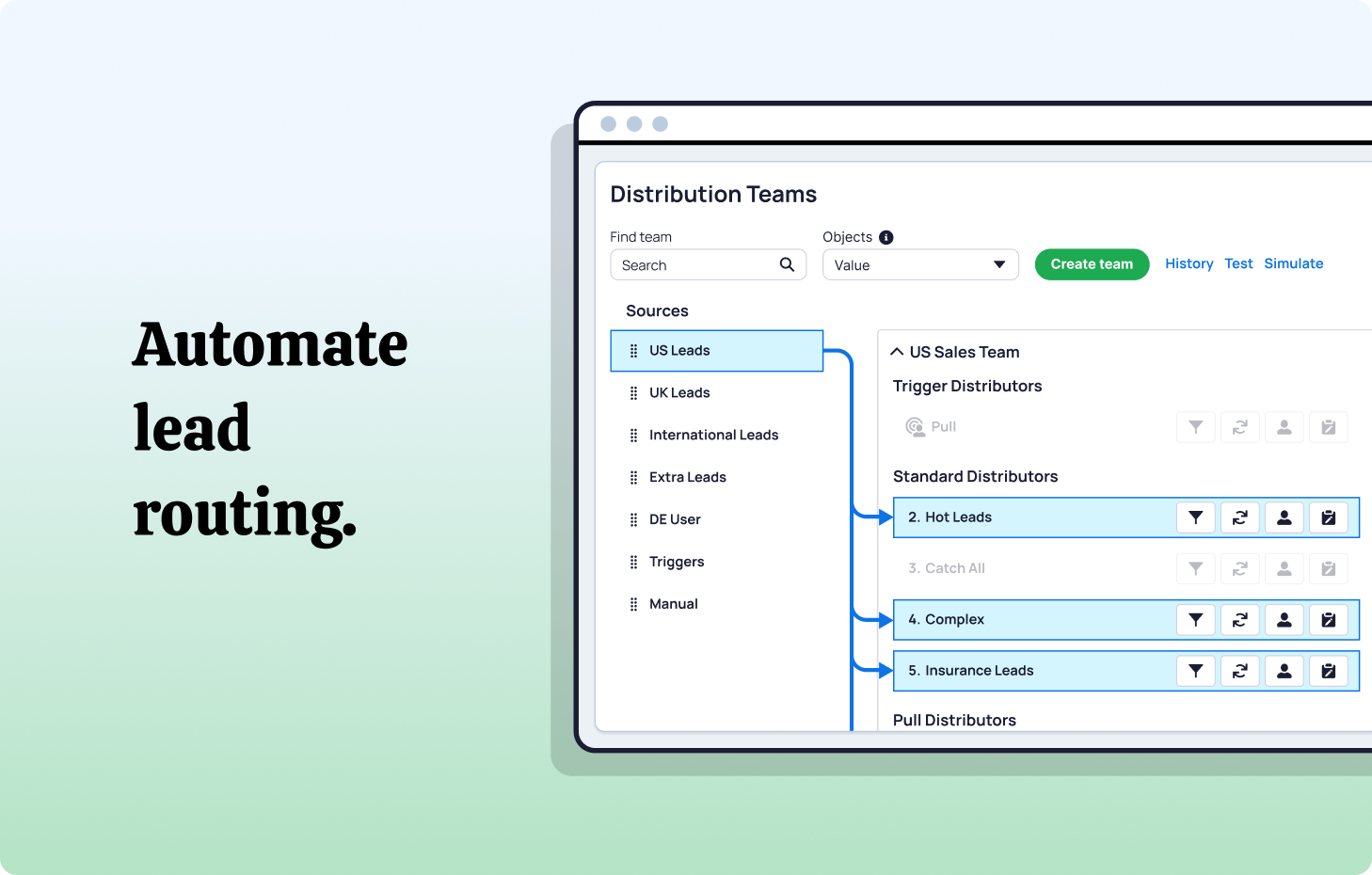
2. Prevent duplicates.
Why it matters: Duplicates waste time, split context, and trigger double calls. Ideally dedupe is just behind the scenes magic that your Sales team never needs to see.
How to do it: Turn on Salesforce Duplicate Management. In Distribution Engine, enable Lead Matching to link Lead-to-Lead, Lead-to-Contact, and Lead-to-Account, and optionally merge dupes or auto-convert with context so sellers keep the full picture.
Start here: Define matching rules, then activate Lead Matching in Distribution Engine so near-matches link and route correctly.
Measure: Duplicate prevention rate, % merged, rejected leads due to dupes.
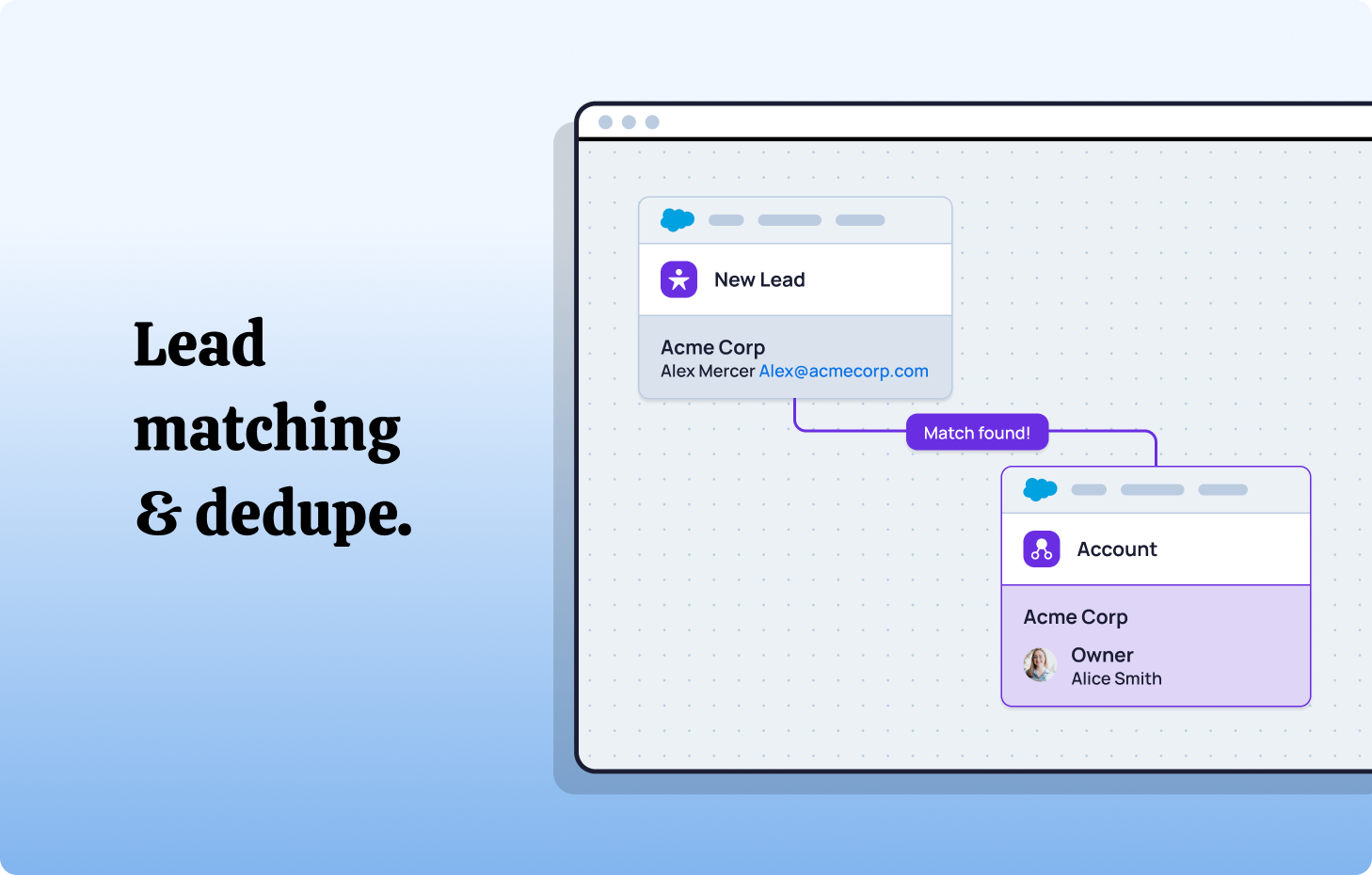
3. Prioritise with lead scoring.
Why it matters: Not all leads are equal. High-intent buyers should skip queues.
How to do it: Use Einstein Lead Scoring or your preferred model from your marketing automation platform to set scoring criteria. For best results enrich the lead and screen against your customer profile criteria for relevance. Then stamp P1/P2/P3 with Distribution Engine’s Custom Classification and drive routing and SLAs from the band.
Start here: Classify into priority groups and point the highest bands at faster SLAs and senior queues.
Measure: Time-to-first-touch and conversion by score band.
4. Match leads to skills.
Why it matters: Give your prospect the best first impression by pairing them with the best rep for the job, off the bat. Matching to expertise lifts first-call resolution and meetings.
How to do it: Translate your team’s skills into Tags, such as their level of experience, the languages they speak, their product specialisms or industry knowledge. In Distribution Engine, use Team Member Tags and the skill-based matching pattern with graceful fallback when specialists are busy.
Start here: Use Distribution Engine to add skill tags that live natively in Salesforce, then build your routing around those Tags.
Example: A lead inbounds from Acme Bank in New York. Simon, is the Senior AE for Banking in the US and English speaking regions. So thanks to the ‘Banking’ sector and ‘English’ language tags, Simon will get this lead (and others just like it) every single time.
Measure: First-call-to-meeting and win rate for skill-matched vs non-matched, rejections due to skill mismatch.
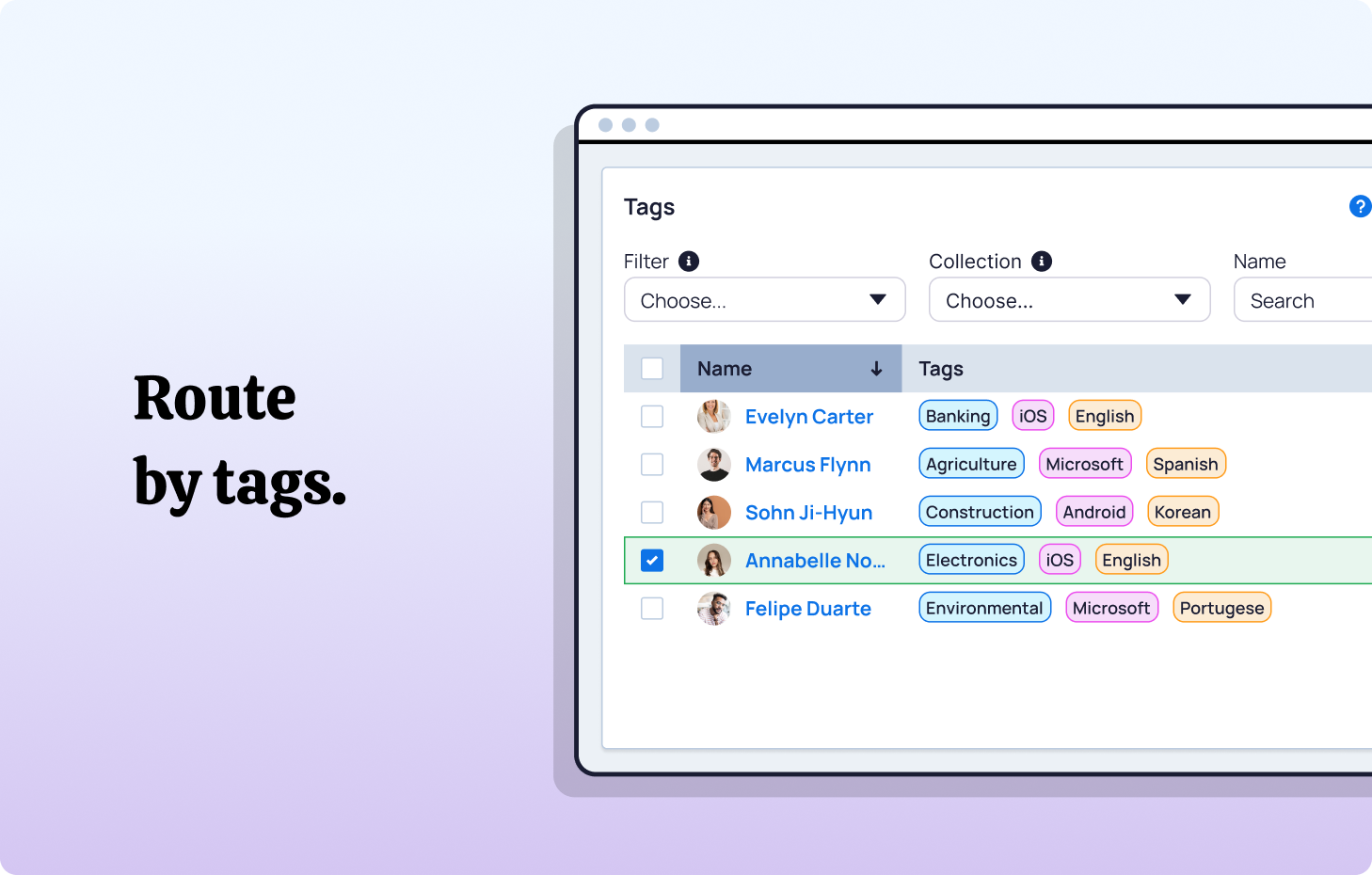
5. Route by territory.
Why it matters: Time zones, languages, and account-ownership rules slow you down when misrouted.
How to do it: Use Distribution Engine’s Territory Classifier to detect region down to ZIP and infer state from dial code, then combine with licensed-rep or account-owner rules.
Start here: Configure geography-based rules in the Territory Classifier, then route via a Territory distributor.
Measure: Reroute rate, after-hours assignments, response time by region.
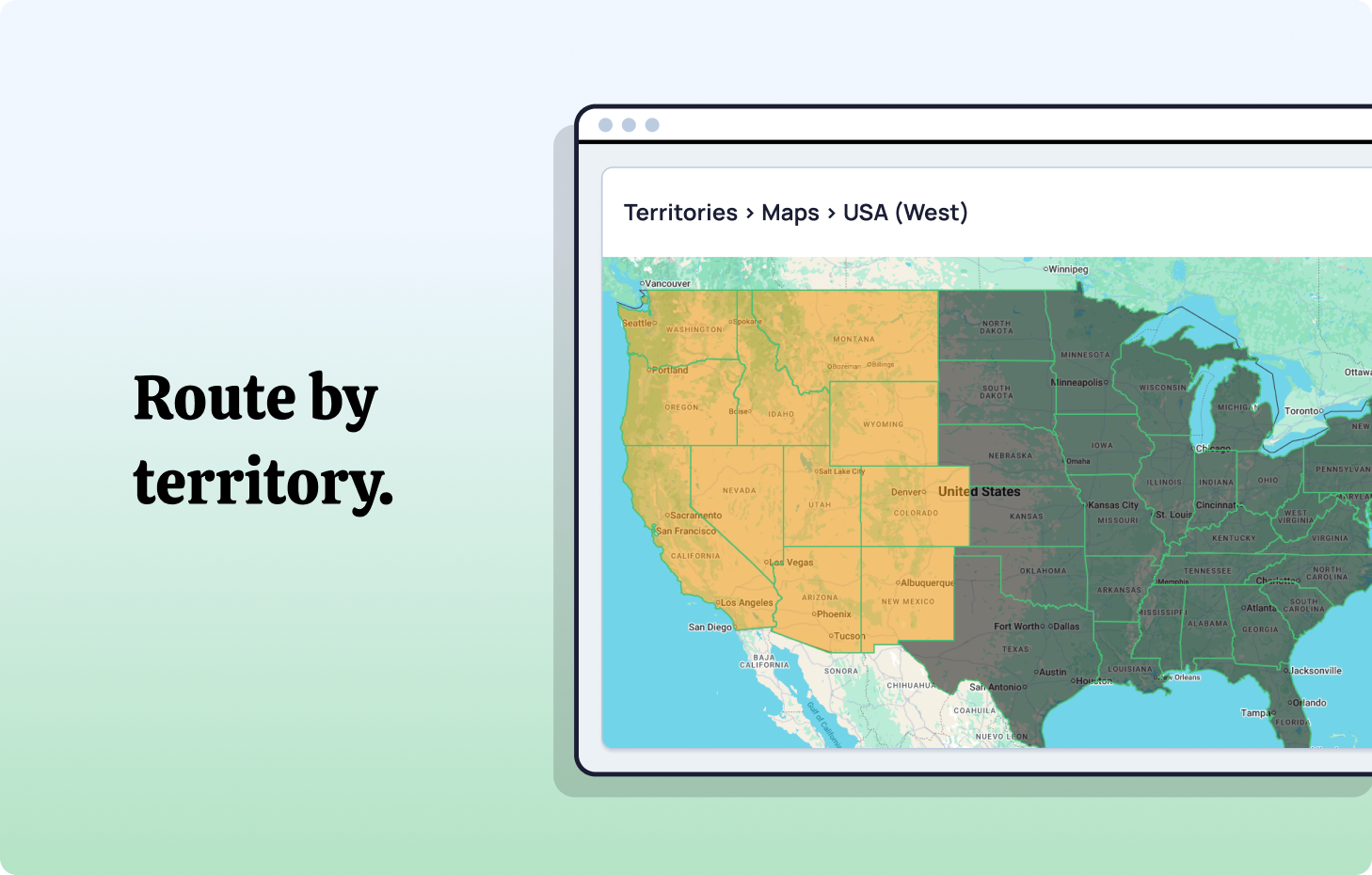
6. Balance workloads with round robin.
Why it matters: Fairness stops cherry-picking and cuts idle records.
How to do it: In Distribution Engine, choose round robin and set the scope (team or distributor). Combine with Sticky Assignment or weighting where needed.
Start here: Configure distributor so each rep is routed an even share.
Measure: Assignments-per-rep variance and time-to-first-touch variance.
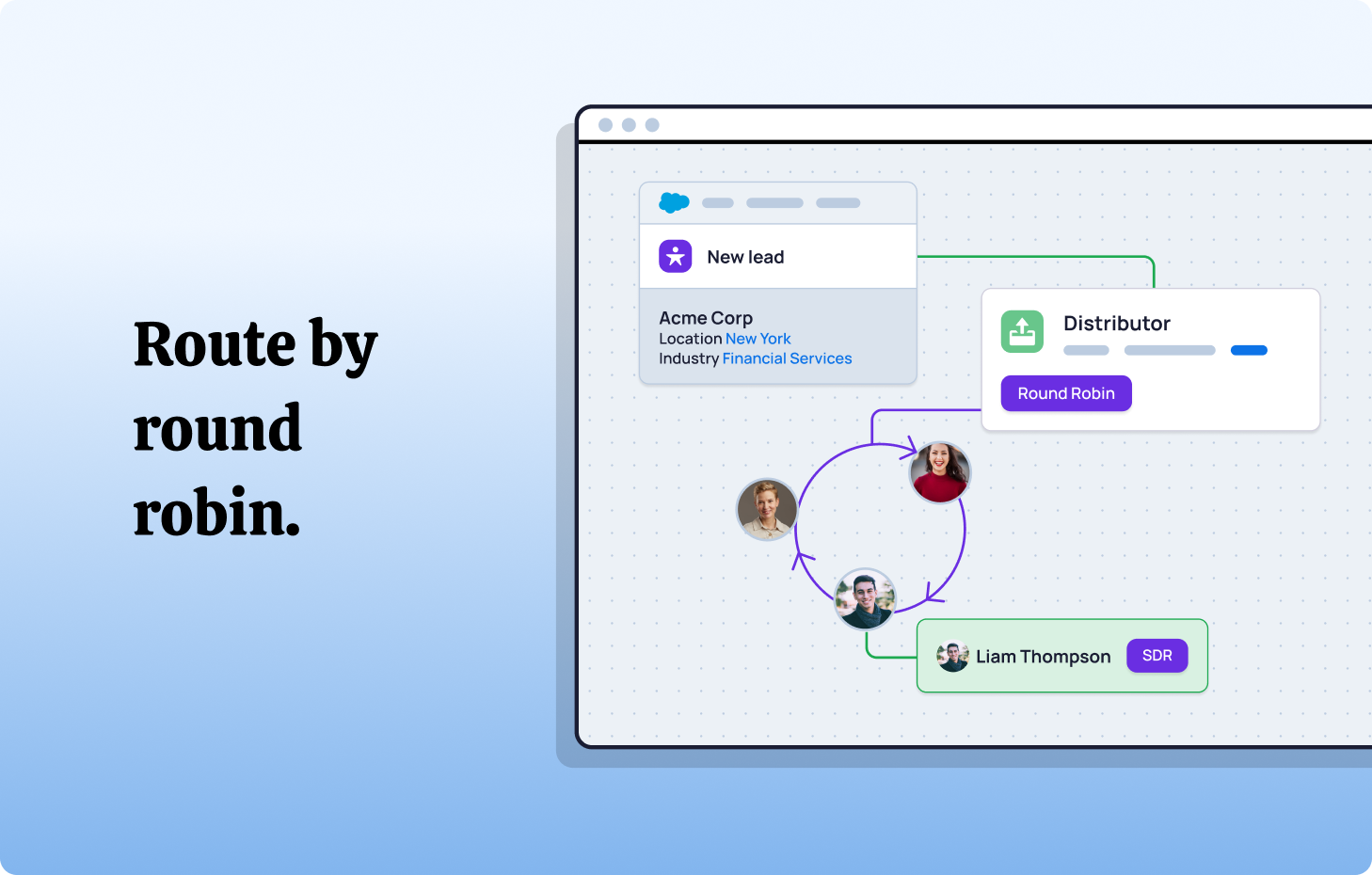
7. Distribute by rep workload capacity.
Why it matters: Overloaded reps respond late; under-utilised reps sit idle.
How to do it: Use Load Balancing with Caps to set a limit on the number of leads reps can work so new leads are routed only to reps under threshold.
Go further by applying weighting ratio so that your more experienced reps get a higher threshold than your new-starters (Tags based on experience level do the lifting here in the background).
Finish up with an Active Cap for hot leads so that the highest value leads are spread evenly.
Start here: Track active load and set Caps per distributor and by Tag when different work types have different limits.
Measure: SLA attainment vs load, average open leads per rep.
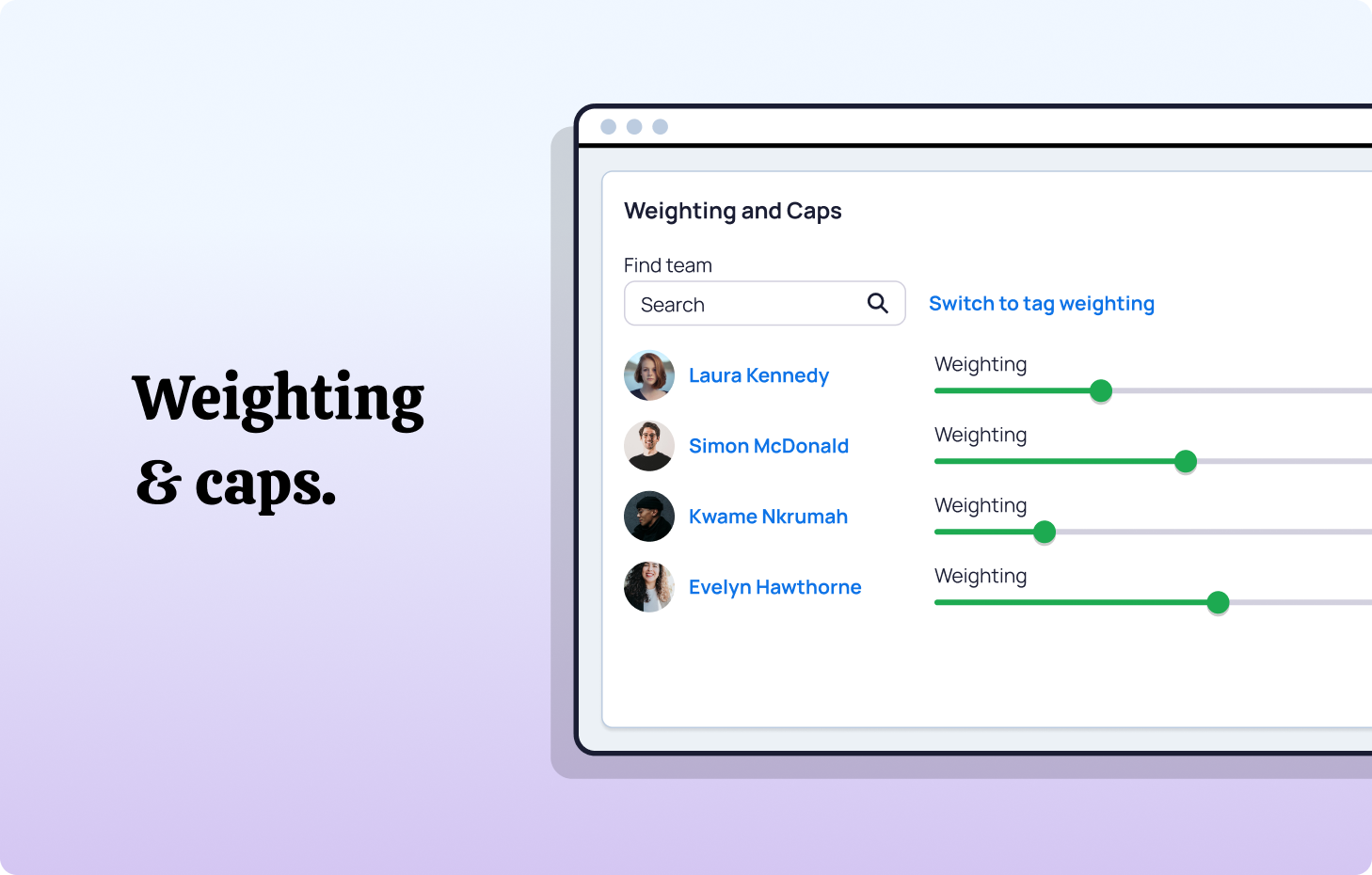
8. Use real-time alerts and notifications.
Why it matters: Visibility drives accountability and action. Reps need instant visibility when they’re up next or close to breaching a SLA.
How to do it: Turn on the seller widget for assignment visibility and a SLA countdown; pair with Salesforce, Slack or email notifications as needed.
Start here: Enable widget alerts and add the component to the console or homepage.
Measure: Speed-to-lead lag and % of breaches with prior alert.
9. Enforce SLAs with auto-reassignment.
Why it matters: SLAs without consequences drift. Automatic reassignment protects the lead and the customer experience.
How to do it: Enable team-level SLAs and Auto-Reassign so overdue records move automatically.
Start here: Apply a 10–15 minute target for P1 web leads with an alert at 10 minutes and auto-reassign at 15 minutes.
Measure: SLA attainment, auto-reassign count, and recovery conversion after reassignment.
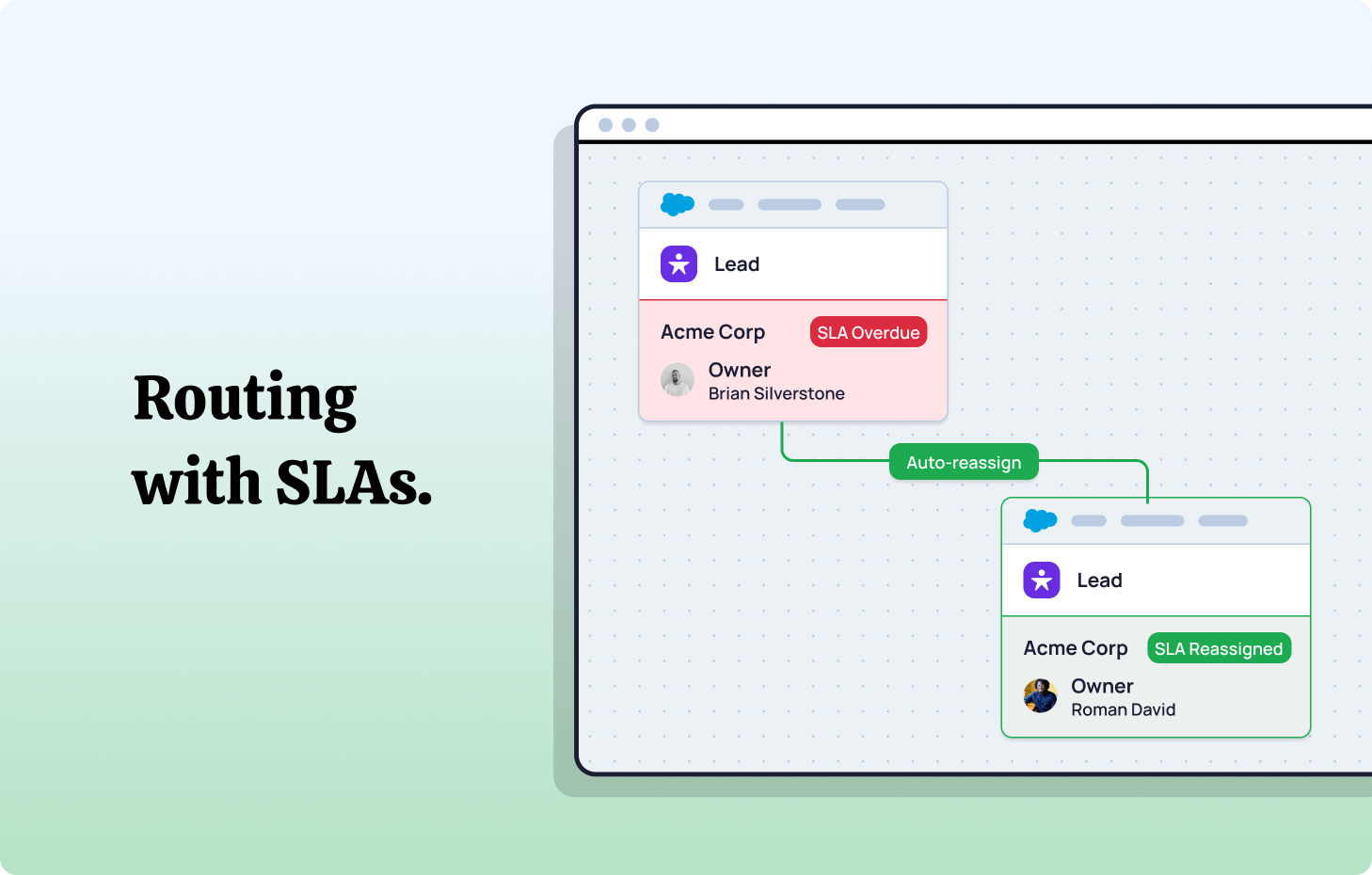
10. Integrate scheduling automation.
Why it matters: The biggest stall often comes after first contact. Manual calendaring eats days.
How to do it: Use NC Squared’s Salesforce-native Booking Engine to check availability, route meetings by ownership or territory, respect working hours, and handles all the meeting set up and invites for you. Then use Booking Engine to handle scheduling, making sure the meeting is with the right Account Executive.
Start here: Arm your SDRs with Booking Engine so they can turn positive discovery calls into meetings on the spot by handing off and routing meetings while on the phone with the prospect.
Measure: Median first-touch-to-meeting, no-show rate, time-to-qualified-opportunity.
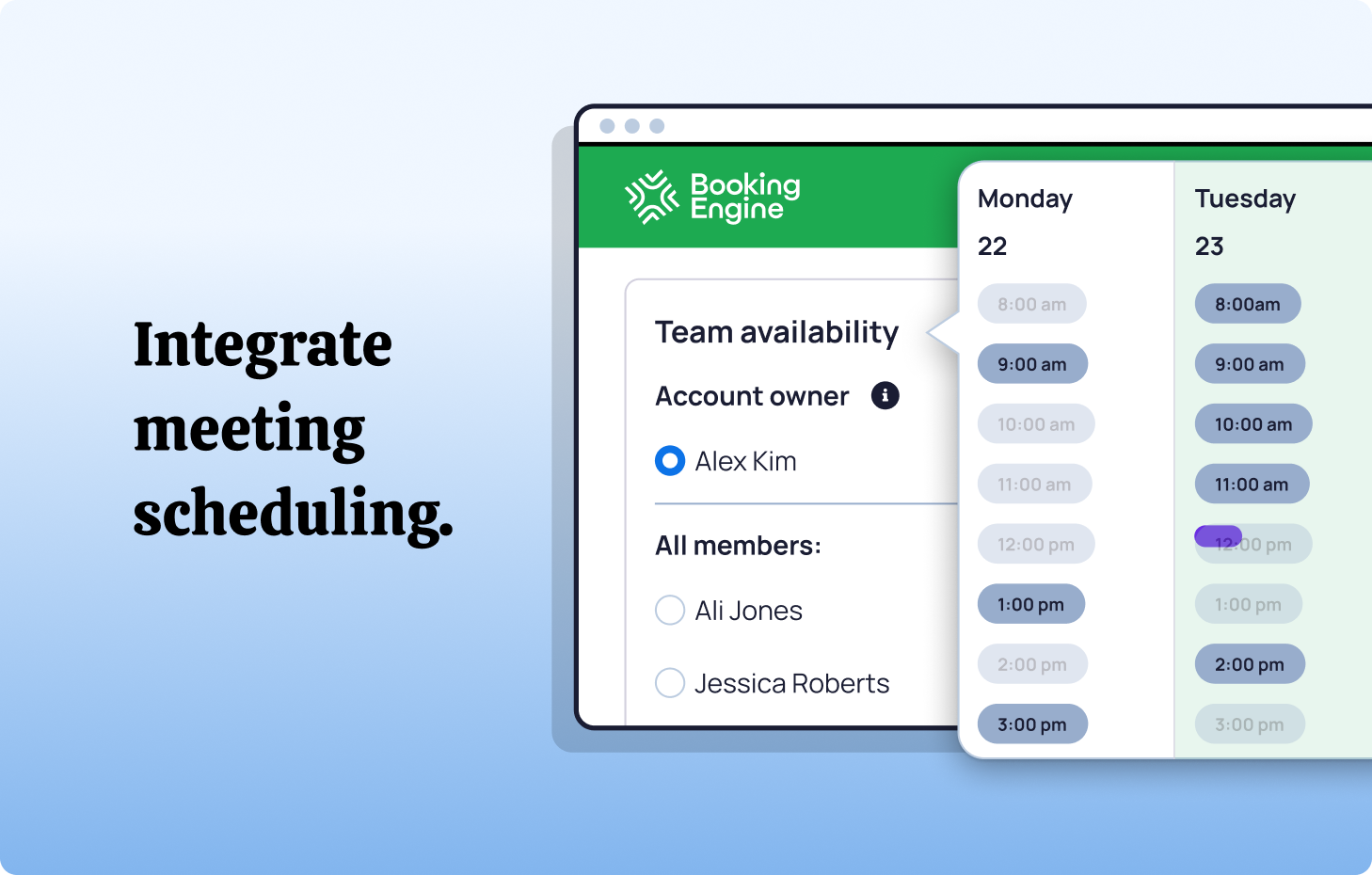
Proof it works.
360Learning lifted lead-assignment accuracy to 97%, held <10-minute SLAs, and increased conversion 40% after implementing Distribution Engine.
Shutterstock saved 60 hours per week, cut response time by 6.5 hours, and consolidated 18 queues with Distribution Engine’s tagging and routing.
Common issues and how to mitigate them.
Every practice has a catch:
1) Automation means trusting your rules
Issues: Brittle logic, conflicting tools, silent failures, and over-automation that hides context.
How to Mitigate:
- Governance: One inventory of rules/Flows with owner, purpose, last review.
- Real testing: Sandbox with production-like data; feature flags; time-boxed “experiments.” Simulate rules and debug before implementing.
- Guardrails: Rate caps on reassignments, human-in-the-loop for risky steps, clear overrides.
- Observability: Audit log + error alerts; auto-assign dashboard, reversions, failure counts.
- Rationalize: Standardize on Distribution Engine and Booking Engine as your primary, auditable orchestration layer.
Takeaway: Trust = visibility + explainability (plus easy roll-back if you need).
2) SLA reassignment can feel unfair
Issues: Off-hours breaches, clock resets on handoffs, timers running while you wait on the customer, and capacity blind spots.
How to mitigate:
- Calendar-aware SLAs: Regional business hours; exclude weekends/holidays.
- Capacity-based routing: Assign by active load, not basic round-robin.
- Make time visible: Show SLA countdown for each record.
- Monthly audit: Heatmap breaches by hour/queue to tune thresholds.
Takeaway: SLAs should feel fair, not punitive.
3) Lead scoring only works if data is solid
Issues: Dirty/missing inputs and bot noise train bad signals; black-box scores erode trust.
How to mitigate:
- Define “scorable”: Require company, role, verified email before routing on score.
- Hygiene: Required fields, dedupe, bot filtering, baseline enrichment.
- Explainability: Publish drivers/thresholds; show “why” on the record.
- Calibration: Quarterly backtest vs. Won/Lost; adjust weights; drop weak signals.
- Feedback loop: Reps tag Good/Bad Fit to review outliers or retrain.
Takeaway: Route on clean, explainable signals you can tune.
How NC Squared Helps.
Distribution Engine by NC Squared is built for this exact problem. 100% Salesforce-native - no integrations, no silos, no extra platforms. Keep your team super-responsive, and clear the way to closed-won with smart lead routing and meeting scheduling.
Included in Distribution Engine:
- Deeply flexible routing → Round robin, territory, skill, or capacity.
- Smart automation → Real-time assignment, SLA timers, auto-reassignment.
- Analytics → Workload, performance, SLA dashboards all in Salesforce
- No code → Teams can own their workflows without code or devs..
That’s why 20,000+ users trust NC Squared to keep leads moving and revenue flowing.
With Distribution Engine, all capabilities are Salesforce-native. Data stays in Salesforce, with pre-distribution classification and post-distribution tracking for auditability.
Start-Here Checklist.
If you want fast wins, begin with these five:
- Automate lead assignment from capture
- Prevent duplicates
- Balance workloads with simple round robin
- Add routing logic at the lowest common denominator that reflects the way your sales team is structured (eg. SMB vs Enterprise, major GEOs) before you go deeper.
- Enable real-time alerts
- Apply SLA timers with auto-reassignment
Get these right, and the rest builds naturally.
Takeaway.
Speed to lead isn’t about working harder. It’s about building smarter workflows in Salesforce. The teams that win? They’re the ones who respond first, engage fast, and never let a lead slip.
Fancy giving Distribution Engine a try?
Have a play around for free, or get in touch if you’d prefer to chat.
Take us for a spin with a 30 day Free Trial
Have a play around for free, or get in touch if you’d prefer to chat.
%20dark.avif)